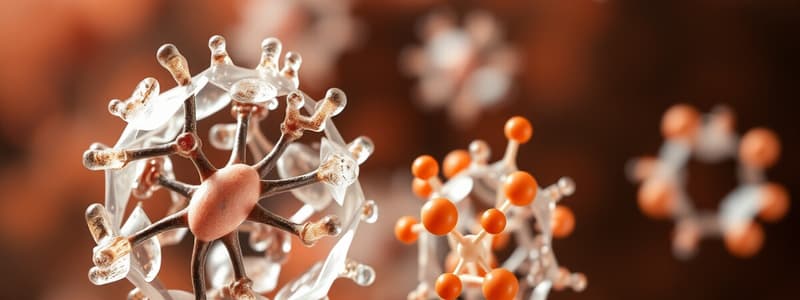Podcast
Questions and Answers
What is the primary characteristic of COX1 enzymes?
What is the primary characteristic of COX1 enzymes?
- Inducible and expressed during inflammation
- Responsible for thromboxane production
- Only present in the kidneys
- Constitutively expressed in all body cells (correct)
How does COX2 differ from COX1 in terms of expression?
How does COX2 differ from COX1 in terms of expression?
- COX2 is the only type present in the GI tract
- COX2 is expressed in all cells at all times
- COX2 is only active during inflammation (correct)
- COX2 is irreversibly inhibited by aspirin
Which class of prostaglandins is primarily responsible for vasoconstriction?
Which class of prostaglandins is primarily responsible for vasoconstriction?
- Leukotrienes
- Prostacyclins
- Thromboxanes (correct)
- PGD/PGE
What effect does aspirin have on COX enzymes?
What effect does aspirin have on COX enzymes?
What is the primary effect of prostacyclins in the body?
What is the primary effect of prostacyclins in the body?
Why may COX1 selective inhibitors lead to gastrointestinal side effects?
Why may COX1 selective inhibitors lead to gastrointestinal side effects?
Which statement best describes the role of thromboxanes?
Which statement best describes the role of thromboxanes?
Which of the following statements is true regarding the use of aspirin?
Which of the following statements is true regarding the use of aspirin?
What is a significant risk associated with the use of COX inhibitors in patients?
What is a significant risk associated with the use of COX inhibitors in patients?
Why is indomethacin particularly indicated for closing a patent ductus arteriosus (PDA)?
Why is indomethacin particularly indicated for closing a patent ductus arteriosus (PDA)?
What is a contraindication for using indomethacin?
What is a contraindication for using indomethacin?
Which drug is a selective COX2 inhibitor mentioned in the content?
Which drug is a selective COX2 inhibitor mentioned in the content?
What is the effect of increased COX2 activity on cardiovascular health?
What is the effect of increased COX2 activity on cardiovascular health?
How do ibuprofen and naproxen differ from aspirin?
How do ibuprofen and naproxen differ from aspirin?
What is a common side effect of using COX inhibitors?
What is a common side effect of using COX inhibitors?
Which statement about platelets is accurate regarding COX inhibition?
Which statement about platelets is accurate regarding COX inhibition?
Study Notes
COX Enzymes Overview
- Two types of cyclooxygenase (COX) enzymes: COX-1 and COX-2.
- COX-1 is constitutively expressed in all body cells, particularly in the gastrointestinal (GI) tract.
- COX-1 selective inhibitors often lead to GI side effects such as ulcers and gastroesophageal reflux disease (GERD).
- COX-2 is inducible and expressed during inflammation and inflammatory diseases; also sequestered in the kidney.
Prostaglandins Classes
- Three main classes of prostaglandins:
- Prostacyclins: Promote vascular dilation and decrease platelet aggregation; limit thrombus formation.
- Thromboxanes: Induce vasoconstriction and increase platelet aggregation, opposing the effects of prostacyclins.
- PGD/PGE: Cause vasodilation and raise vascular permeability; less emphasis in this context.
Aspirin
- Used for managing inflammation, pain, and fever; less effective as an antipyretic compared to acetaminophen (Tylenol).
- Primarily COX-1 selective but has some COX-2 activity.
- Irreversibly binds to COX enzymes, leading to sustained reductions in thromboxane production.
- Increases vasodilation by sparing prostacyclins.
- Contraindicated in children due to the risk of Reye syndrome and should be avoided in hemophilia patients.
- Notable for its utility in preventing thrombosis and clotting.
Indomethacin
- Similar indications to aspirin: pain and inflammation; additionally indicated for closing a patent ductus arteriosus (PDA).
- Reduces prostaglandin levels, facilitating the closure of PDA.
- Reversibly binds to COX-1 and COX-2 enzymes.
- Contraindicated with lithium treatment due to the risk of lithium accumulation and potential toxicity.
Ibuprofen and Naproxen
- Both indicated for pain management, inflammation, and act as antipyretics.
- Reversible binding to COX-1 and some COX-2 activity.
- Ibuprofen is also indicated for patent ductus arteriosus.
Celecoxib
- Notable as a selective COX-2 inhibitor, differing from other mentioned NSAIDs.
- COX-2 is crucial for sodium and water excretion and renin release.
- Inhibition of COX-2 shifts balance towards thromboxane dominance, increasing thrombotic risk.
- Since platelets lack COX-2, they continue to produce thromboxanes, raising concerns for cardiovascular issues such as thrombosis.
Studying That Suits You
Use AI to generate personalized quizzes and flashcards to suit your learning preferences.
Description
This quiz covers the characteristics and differences between COX1 and COX2 enzymes, their expression levels, and the role of prostaglandins in bodily functions. Additionally, it addresses the effects of aspirin on these enzymes and the potential gastrointestinal side effects of COX1 selective inhibitors. Assess your understanding of these critical biochemical concepts.




